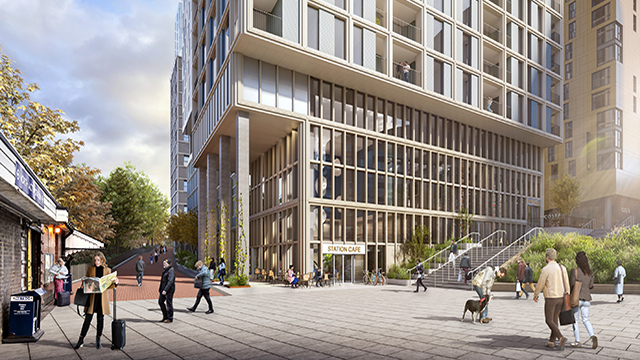Practice and procedure – Strike out – Cause of action estoppel – Merger – Claimants seeking damages against defendants for alleged breaches of repairing obligations in leases – First defendant applying to strike out claim on ground that first claimant seeking to re-litigate issues determined in previous county court proceedings – Whether abuse of process to re-litigate same issue – Whether parties bound by judgment in earlier action – Application granted
The claimants owned long leasehold interests in flats in Ivor Court, Gloucester Place, London NW1. Until 11 March 2011, the first defendant was the freehold owner of Ivor Court and the lessor under the claimants’ various leases. Since that date, the freeholder and lessor had been the second defendant. The claimants claimed damages against the defendants for alleged breaches of their repairing obligations under the leases.
The first defendant applied to strike out the claim pursuant to CPR 3.4(2)(b) on the ground that it was an abuse of process. The first defendant complained that it had already been sued by the first claimant in the county court in respect of alleged breaches of its repairing obligations. It argued that it was an abuse of process to re-litigate the same issue and that the parties were bound by the judgment in the first action. In so far as the second claim pursued a new cause of action, the first defendant sought to strike it out in reliance on the principle in Henderson v Henderson (1843) 3 Hare 100.
The claimant argued that the court should focus not on the pleadings in the county court claim but upon the judgment. While the case was pleaded more widely, damages were only awarded for disrepair to the third-floor common parts. Accordingly, there was no duplication and the second action was not an abuse.
Held: The application was granted.
(1) The starting point was to consider whether the second claim was brought upon the same cause of action as the first. The focus was upon comparing the causes of action relied upon in each case and not the particulars of breach or loss and damage. New particulars were not particulars of a new cause of action if they sought to plead further particulars of breach of the same promise or tort or further particulars of loss and damage. Both cause of action estoppel and merger operated to prevent a second action based on the same cause of action. Such bar was absolute and applied even if the claimant was not aware of the grounds for seeking further relief, unless the judgment in the first case could be set aside. Even if the cause of action was different, the second action might nevertheless be struck out as an abuse under the rule in Henderson v Henderson where the claim in the second action should have been raised in the earlier proceedings, if it was to be raised at all. In considering such an application the onus was upon the applicant to establish abuse. The mere fact that the claimant could with reasonable diligence have taken the new point in the first action did not necessarily mean that the second action was abusive. The court was required to undertake a broad, merits-based assessment taking account of the public and private interests involved and all of the facts of the case. The court’s focus had to be on whether, in all the circumstances, the claimant was misusing or abusing the process of the court by seeking to raise before it the issue which could have been raised before. The court would rarely find abuse unless the second action involved unjust harassment of the defendant: Henderson, Conquer v Boot [1928] 2 KB 336, Arnold v National Westminster Bank plc [1991] 2 AC 93, Johnson v Gore Wood & Co [2002] 2 AC 1 and Virgin Atlantic Airways Ltd v Premium Aircraft Interiors UK Ltd [2013] UKSC 46 applied.
(2) The critical question was whether the second action was based on the same cause, or causes, of action, and not whether it pleaded the same particulars of breach or loss and damage. The first claimant could not bring one action for disrepair to the third-floor common parts and a second action for disrepair during the same period of time to the rest of the building. The essence of the county court claim was that the first defendant was alleged to have been in breach of its repairing covenants. While the case was pleaded by reference to discrete contractual obligations of the lease, the first claimant’s disrepair case was encapsulated in a single sentence in his particulars of claim: “In breach of the express covenants, the defendant failed to expeditiously effect appropriate repairs of the common parts of the block”. Such claim was founded on a single cause of action; namely, the first defendant’s alleged breaches of its repairing obligations under the lease. The first claimant’s claim against the first defendant in the present proceedings was a claim upon the same cause of action. It was therefore barred by both cause of action estoppel and merger.
(3) In any event the court would have struck out the claim as an abuse of process. The first claimant’s pleaded claim in the first action was not limited to the third floor but extended more widely to a claim in respect of defects to the common parts of the building. All of the defects now relied upon came within the general and unparticularised plea in the particulars of claim in the county court. Even ignoring those wide words, there was considerable duplication between the more specific claims pleaded in the two actions. Balancing the first claimant’s interest in being able to pursue his further claim against the first defendant’s interest in not being vexed a second time in respect of its repairing obligations and the public interests in access to the court and finality, the balance in this case came down clearly in favour of the defendant. The claims now pursued were further particulars of disrepair by the same landlord and should have been made in the first action. Allowing the second claim to proceed against the first defendant would amount to unjust harassment.
Antonia Halker (instructed by Benchmark Solicitors LLP) appeared for the first claimant; Adam Rosenthal (instructed by Charles Russell Speechlys LLP) appeared for the first defendant.
Eileen O’Grady, barrister
Click here to read a transcript of Moorjani and others v Durban Estates Ltd and another






